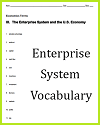| The Enterprise System and the United States Economy |
| www.studenthandouts.com ↣ Social Studies ↣ Economics ↣ U.S. Economy and Enterprise |
 |
||||||||||
| Enterprise System Vocabulary |
|
In economics, the term "enterprise system" typically refers to an economic system characterized by private ownership of businesses and the pursuit of profit as a primary motivation. It is synonymous with a market-oriented or capitalist economic system. Students are to be taught the key features of an enterprise system. Private Ownership: In an enterprise system, most businesses and resources are owned and operated by private individuals, corporations, or entities rather than the government. Private ownership allows for individual and corporate decision-making in pursuit of profit. Profit Motive: Profit is a central driver of economic activity in an enterprise system. Businesses aim to generate profits by producing goods or providing services that consumers want, and they make decisions to maximize their profitability. Market Allocation: The allocation of resources, production, and distribution of goods and services is primarily determined by market forces. Prices are typically set by supply and demand dynamics, and businesses respond to market signals to meet consumer preferences. Competition: An enterprise system promotes competition among businesses. Competition can lead to innovation, efficiency, and lower prices as firms seek to gain a competitive advantage and capture market share. Entrepreneurship: The enterprise system encourages entrepreneurship, where individuals and businesses take risks to start new ventures or expand existing ones. Entrepreneurship is vital for economic growth and dynamism. Consumer Choice: Consumers have the freedom to choose from a variety of products and services available in the market. This choice allows consumers to express their preferences and influences the direction of production. Limited Government Intervention: While governments in an enterprise system may establish regulations and provide certain public goods and services (e.g., infrastructure, education, healthcare), they generally have a limited role in directing economic activities compared to planned or command economies. Profit and Loss Mechanism: In an enterprise system, the profit and loss mechanism is a crucial feedback mechanism. Businesses that generate profits are encouraged to expand and innovate, while those that consistently incur losses may need to adapt or exit the market. Property Rights: Strong property rights are essential in an enterprise system. They provide individuals and businesses with legal protection for their assets and investments, which encourages investment and economic activity. Economic Growth: An enterprise system is often associated with economic growth due to its ability to incentivize innovation, efficient resource allocation, and the pursuit of profit. It is important for students to note that various countries may have mixed economic systems that combine elements of an enterprise system with some degree of government intervention or regulation. These mixed systems can take different forms, and the balance between government and market forces can vary widely. The specific characteristics and degree of government involvement in economic affairs can depend on political, social, and cultural factors in each country. Students should be led to examine various aspects of a national economy to determine what system exists in a particular country, such as the United States. |
| www.studenthandouts.com ↣ Social Studies ↣ Economics ↣ U.S. Economy and Enterprise |








